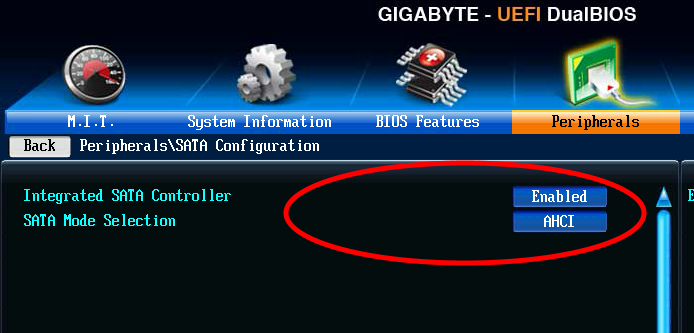Leaderboard
Popular Content
Showing content with the highest reputation on 09/03/2025 in Posts
-
This may be useful for anyone else using an older than normal Windows PC. Typically after at least a decade's use (my own experience is actually 12 years) the CMOS battery on a desktop PC's motherboard will start to fail. This is characterized by occasional then more frequent PC boots direct into the BIOS settings. Eventually it will fail completely and reset to the original MB BIOS and the default settings. The problem you may have is that even after you replace the battery and reflash the BIOS, so you're using exactly the same version, it still may not boot into Windows. In my case it got to the point the Windows 7 icon starts to appear then freezes. If you try the repair options you'll be offered Windows Diagnostic tools will report all OK but one error that can't be identified or fixed. This is can set you off on a totally unnecessary diagnostic and repair path which will waste your time and probably won't find let alone fix the actual cause. This is a very minor one BUT if you don't know about it you'll quickly be tempted to go through all those hoops. The cause is that with an older MB the 'optimized' default settings actually return the HDD addressing mode to IDE (Integrated Drive Electronics) when more modern SATA HDDs and SSDs require AHCI (Advanced Host Controller Interface). All you need to do is go into BIOS, find that setting. See the screenshot below for the location of this setting with older Gigabyte MBs. Swap it back to AHCI, save and reboot. You might get a Windows Diagnostic repair screen option first time but if you just choose to boot Windows normally - with any luck, it will. Hope this helps someone here avoid the hassle I went through trying to identify the cause of the boot failure after I had to replace the CMOS battery.1 point
-
Greetings :-) Thanks. Updated Python3.11.4_openssl3.5.2.zip PS. Why don't You include openssl.exe in the set? Best regards1 point
-
Hello Reino (OT, but I'm really missing your Vista-compatible FFmpeg compiles ) While your OpenSSL binaries (archive "openssl-3.5.2-win32-shared-xpmod-sse.7z") may very well be XP+ compatible , they don't work out-of-the box as CPython dependency by swapping the already existing DLLs (of openssl v3.1.0-dev) inside cmalex's CPython assemblies with them; he's been using the same (quite deprecated and now rather insecure ) v3.1.0-dev DLLs in his 3.8.13, 3.9.13, 3.10.8 and 3.11.4 CPython offerings, but the thing is the libcrypto-3.dll and libssl-3.dll inside CPython work in conjunction with two Python DLLs, files "_ssl.pyd" and (possibly) "_hashlib.pyd"; the existing .pyd files are incompatible with your own openssl DLLs ... BTW, I'm on Vista SP2 32-bit, so I'm using cmalex's Vista-compatible 3.11.4 assembly; with the original v3.1.0-dev DLLs: python Python 3.11.4 (heads/My3.11.4-dirty:1c368b1ab42, Aug 24 2025, 19:29:33) [MSC v.1900 32 bit (Intel)] on win32 Type "help", "copyright", "credits" or "license" for more information. >>> import ssl >>> ssl.OPENSSL_VERSION 'OpenSSL 3.1.0-dev ' >>> ^Z <redacted>\3.11.4\cmalex\Python3114-32_Vista> Overwrite them with your own v3.5.2 DLLs and... python Python 3.11.4 (heads/My3.11.4-dirty:1c368b1ab42, Aug 24 2025, 19:29:33) [MSC v.1900 32 bit (Intel)] on win32 Type "help", "copyright", "credits" or "license" for more information. >>> import ssl Traceback (most recent call last): File "<stdin>", line 1, in <module> File "<redacted>\3.11.4\cmalex\Python3114-32_Vista>\Lib\ssl.py", line 100, in <module> import _ssl # if we can't import it, let the error propagate ^^^^^^^^^^^ ImportError: DLL load failed while importing _ssl: The specified procedure could not be found. >>> ssl.OPENSSL_VERSION Traceback (most recent call last): File "<stdin>", line 1, in <module> NameError: name 'ssl' is not defined >>> ^Z <redacted>\3.11.4\cmalex\Python3114-32_Vista> I guess newer versions of "_ssl.pyd" and "_hashlib.pyd" must be provided for openssl-3.5.2 compatibility ... @nicolaasjan openssl-3.1.0-dev inside cmalex's assemblies (both 3.10.18 and 3.11.4, both XP/Vista variants) can be updated to a slightly more recent version, openssl-3.1.2, by using the OpenSSL-3.1.2 DLLs cmalex had compiled in the past for another of his projects, ProxyMII; link below: https://mega.nz/folder/68dj2YTY#As2w31IO4Smr7gy6p1ciSg/file/Pl9yzapZ Proof: python Python 3.11.4 (heads/My3.11.4-dirty:1c368b1ab42, Aug 24 2025, 19:29:33) [MSC v.1900 32 bit (Intel)] on win32 Type "help", "copyright", "credits" or "license" for more information. >>> import ssl >>> ssl.OPENSSL_VERSION 'OpenSSL 3.1.2 1 Aug 2023' >>> ^Z <redacted>\3.11.4\cmalex\Python3114-32_Vista> NB: When using the Vista variants of py3.10.18/3.11.4 to compile yt-dlp_x86.exe for Vista, none of the wrapper DLLs (kernelxp.dll, ntext.dll, psapi.dll) are needed; because your resultant yt-dlp.exe binaries (for Vista) still contain file "psapi.dll", redundant on Vista ; come to think of it, I don't think file "ws2_xx.dll" is needed on Vista either, but I'm not dead certain; only cmalex can vouch for that ... Many thanks and praise to both cmalex and nicolaasjan for... keeping the torch lit (i.e. yt-dlp accessible on Win<8.1) ...1 point
-
Greetings Python3.11.4.zip in https://mega.nz/folder/jst2WJ5B#sknEpEBamwPomx8UULWuMA Please any questions about it at https://msfn.org/board/topic/183741-python-3813-for-windows-xp-sp3/ Best regards1 point
-
I am using uBlock Origin 1.53.0 currently ... just wondering if this is what most people are using or is there another better working version available. I guess I found this version last October during a search. Thanks ...1 point
-
I had never heard of Uniextract till mentioned in your post. It's listed as working on Win7 and called 'Universal Extractor 2' at MajorGeeks.com. Is this the same program that you were referring to in your earlier post? Universal Extractor 2.0.0 RC3 / Requires: Windows 10/8/7 (58.6 MB) https://www.majorgeeks.com/files/details/universal_extractor_2.html I also found a portable version at PortableApps listed. It seems to indicate it will work on Windows 7, maybe even Win XP. Universal Extractor 2 (UniExtract2) https://github.com/Bioruebe/UniExtract2 System requirements: In short: Windows XP or newer. However, outdated version of Windows only have limited support: Windows 7: sending feedback requires you to follow this guide by Microsoft, otherwise it will fail Windows XP: any online functionality, such as the updater or the feedback dialog, is disabled for security reasons. Also some extractors might not work. Anything to further add about what version ... hoping to be able to go with the 'portable version' ... I hate to install anything on my computer if I don't have to. Again, thanks for the mention of this program. Sometimes 'this question or that question' leads to more information about 'something new'. Thanks to NotHereToPlayGames and the information on 7zip also working. I have that installed but it won't hurt to also have a version of Extractor available for something 'unusual'. ...1 point
-
Thanks for the replies. I guess I have a slightly newer version. It seems to be working OK. I'm more up on Windows XP than Windows 7 ... so it's all good.1 point
-
@XPerceniol, hello, I see you type even better than before! So looks like you're all fine. I'm glad with the positive progress.1 point
-
@Dave-H This is bit disappointing. So @Mathwiz's guess has been disproved and my suggestion doesn't help too. At next I've made a screenshot of my Root Cerificate Authorities in my system beginning with "Microsoft". So you can compare if one or more are missing. There is less German so I think it won't be a problem to read. https://imgur.com/hX3nGr41 point
-
The only thing I can say in your case you have to check systematicly and seriously what is missing or going wrong. When I had all error codes someone can get and yours too I did all from scratch i.e. you have to reinstall the mentioned updates although they already exist in your system or you have to check deeply if "Restore_WU_XP_2003" has been installed actually properly and so on. It will cost more time but for me it was the only way. By the way I can't see where you come from. There is no flag in your profile but your screenshot tellls me from Asia so maybe it is country related too. And here is a link with information to your error code from Microsoft: https://web.archive.org/web/20130316104325/http://support.microsoft.com/kb/836941 And a bit older version of this article I attach below. There you can find your error code 0x80072F78 "ERROR_WINHTTP_INVALID_SERVER_RESPONSE". https://www.mediafire.com/file/gu3q9b8gtpxwblr/q836941.htm/file1 point
-
@Jonuarl Reden Hi, the suggestion you've quoted is related to error code 0x800072F8F so different to yours. Have you already read the whole thread? I have made a little guide to get MU working. Look here:1 point
-
I think it's not unimportant to have only one ProxHTTPSProxy CA certificate in your system. If regenerating a new one leads to getting two of them then something is going wrong. Maybe your system restores this second old one. So delete all ProxHTTPSProxy CA certificates, make a reboot at first and have a look if your system has restored the old one before regenerating a new one. And only if you want try my suggestion two posts above: "Now I have two suggestions for you. First delete both ProxHTTPSProxy CA certificates and generate a new one from 2017 to 2027 following the guess of @Mathwiz. Delete all certificates in your ProxHTTPSProxy certs folder and let ProxHTTPSProxy generate new certs for all MU related sites (www.microsoft.com, download.windowsupdate.com, fe2.update.microsoft.com, www.update.microsoft.com, update.microsoft.com and so on; you can use Wireshark or more simple NirSoft's HTTPNetworkSniffer for finding all connected sites) by using New Moon browser or Mypal. Then try to access MU using IE and look if it works. Check your settings in Internet Zone too (relevant for accessing http://fe2.update.microsoft.com). The idea is letting a new browser generate these MU relevant certificates. If that doesn't work for you you can go back to ProxHTTPSProxy CA certificate valid until 2025 which was the one originally provided. Of course you can do this all using HTTPSProxy at first too."1 point
-
@Dave-H Ok, your screenshot was a bit misleading. The certificate to the right is in your ProxHTTPSProxy's certs folder and the one to the left is your system root certificate. Therefore you have two ProxHTTPSProxy CA certificates due to the fact that you haven't deleted the old one before installing regenerated certificate. Is that right? Now I have two suggestions for you. First delete both ProxHTTPSProxy CA certificates and generate a new one from 2017 to 2027 following the guess of @Mathwiz. Delete all certificates in your ProxHTTPSProxy certs folder and let ProxHTTPSProxy generate new certs for all MU related sites (www.microsoft.com, download.windowsupdate.com, fe2.update.microsoft.com, www.update.microsoft.com, update.microsoft.com and so on; you can use Wireshark or more simple NirSoft's HTTPNetworkSniffer for finding all connected sites) by using New Moon browser or Mypal. Then try to access MU using IE and look if it works. Check your settings in Internet Zone too (relevant for accessing http://fe2.update.microsoft.com). The idea is letting a new browser generate these MU relevant certificates. If that doesn't work for you you can go back to ProxHTTPSProxy CA certificate valid until 2025 which was the one originally provided. Of course you can do this all using HTTPSProxy at first too. Due to the fact that HTTPSProxy and ProxHTTPSProxy is working flawlessly for me and for other members it will work for you too. There is one thing or more you have missed and you have to find it. Don't give up!1 point
-
The old trick to avoid long searches of MU was reinstalling latest cummulative IE update. Resetting of datastore.edb can help too. By the way my search lasts only seconds.1 point


